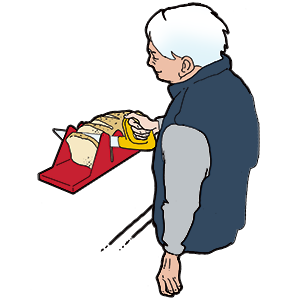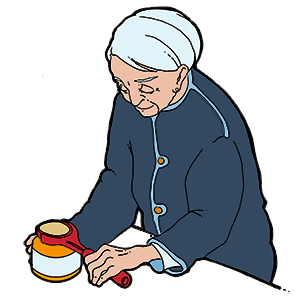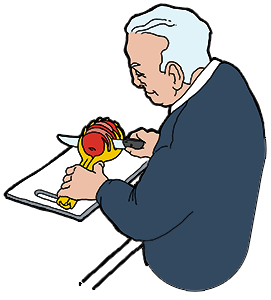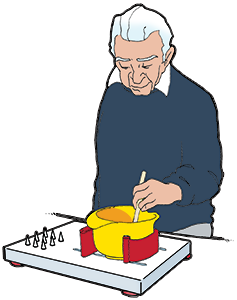Assistive products for cooking
Last updated 27-10-2022 In this guide, you can find an introduction to assistive products for cooking, which may be useful, if you have a physical disability, severely reduced sight, or special needs due to a cognitive disability.
In this guide, you can find an introduction to assistive products for cooking, which may be useful, if you have a physical disability, severely reduced sight, or special needs due to a cognitive disability.Some of the mentioned aids are assistive products for preparing food and drinks. . Others support your working posture, e.g. activity chairs, or enhance your possibilities of differentiating or decoding, e.g. materials and tools for labeling.
Finally, you will find information on assistive products, which can support your organizing of the cooking process, including assistive products for structuring activities.
Is this relevant for you?
Assistive products for cooking may be relevant, if you for instance:
- have reduced function in the hand or arm, e.g. due to fractures, arthritis or tremors
- only can use one hand, e.g. due to paralysis
- have severely impaired eyesight
- need physical support or relief, e.g. need to sit down when cooking
- have a cognitive disability, e.g. an acquired brain injury or mental deficiency.
In some cases, you may be granted assistive products for cooking by the local authorities. In other cases, you will have to acquire the assistive products yourself. If you are uncertain about which assistive products best suit your needs, you can consult a professional with the local authorities.
Even if your do not apply the local authorities for a grant for the assistive products, they can still guide you to select and utilize the best possible assistive products. A professional can also help you assess, whether training may help improve your level of functionality.
Reduced function in hand or arm
When you prepare food, it involves many movements, which may be straining for the small joints of the fingers. Several assistive products for cooking activate the larger muscle groups in hands and arms, and thereby go easy on the small finger joints.

Assistive products may include:
- Container openers for e.g. jar lids, tins, bottles, and milk cartons.
- Universal grips for turning the controls of the stove
- Peelers with a thickened grip, e.g. potato peelers
- Assistive products for cutting, chopping, and dividing to prepare food and drink such as kitchen scissors, knives, and graters with thickened, angled, or ergonomic grips.
There are also special scissors. Some of them have a specifically worked out grip, which makes it easier to hold the scissors. Others have a spring mechanism, which makes the scissors open automatically. With this, you do not need so much strength when cutting.

If you have difficulties holding a milk carton when pouring from it, you can use a holder fixed to the carton.
Finally, it may be a help to use a non-slip pad to prevent bowls and plates from sliding on the table.
Cutting frames and slicing grips may be suitable if you have tremors in your hands, or if you for some other reason have difficulties holding on to a loaf of bread, vegetables, a salami, or the like. A slicing grip will grasp the food item to keep a firm grip on it while you are slicing it.
You can also find cutting boards with fixation facilities, where the food item can be fixed, while you are cutting.
One functioning hand
If you can only use one of your hands, you may need assistive products to help you fixating utensils or food items. Under cutting frames and slicing grips, you can find e.g. a cutting frame, which can help you fixating a loaf of bread when you to cut it into slices.

In addition to this, you can find cutting boards, on which you can fix a bowl or food items making it easier for you to stir or cut. The cutting boards often have suction cups underneath to make them sit firmly on the worktop.
If you are only able to use one of your hands and need to peel potatoes, you can use a potato peeler with suctions cubs that you can fix to your worktop or the inside of your sink. You can find various models in peelers. You may also need a vegetable brush with suction cups.
You can find a broad variety of kitchen utensils suited for one-hand operation. You can for instance find a holder for saucepan/frying pan, which you can fasten to your stove by means of suction cups so the frying pan or the saucepan will be fixated while you stir the food.
You can use a tea trolley or a one-hand operated tray for serving or getting around with food items or kitchen utensils.
You can get more inspiration in Persons with One Functional Hand.
Severe loss of vision
If you have a loss of vision, there are a number of assistive products, which may be of help in your kitchen. You can for instance find the following:
- Kitchen scales with speech
- Boiling alerts, which are placed inside the saucepan and make a noise, when the liquid is boiling
- Devices for measuring volume, e.g. a margarine measurer indicating where to cut to get e.g. 50 grams of margarine
- Countdown timers with large numbers or tactile marking
- Talking thermometers
- Fluid level indicators with sensors, that you hang over the rim of e.g. a cup, and which beeps and vibrates when the sensors get wet
- Cutting frames and slicing grips, which help you holding onto food items, you wish to cut. Grooves in the slicing frame ensure an even cut
- Text-to-speech devices and software, e.g. apps and character-reading machines, which you can use for reading a recipe aloud.
For some persons it may be of help to use smart-home products providing the possibility for voice control and text-to-speech functions. For instance, a smart-loudspeaker could be used for reading recipes aloud, and providing answers for questions about baking and cooking times. Furthermore, kitchen and domestic appliances with an internet connection may be easier to control compared to such appliances without internet connection, as operation and messages can be read aloud via a smart-loudspeaker or a smartphone. You can find further inspiration in the guide SmartAT for Household and Daily Life.
If your impairment implies difficulties distinguishing between tinned cans, jars for spices or the like, you can use assistive products for marking. In addition, you can find apps for reading bar codes out loud to get information from labels on tins, glasses etc.
You can read more about this in the guide Assistive Products for Marking.
You can get more advice in The Danish Association of the Blind (Dansk Blindesamfund) guide Den store køkkenguide - 14 gode råd når du går i køkkenet (The Big Kitchen Guide – 14 pieces of good advice for kitchen activities. Only available in Danish).
Physical support or relief
If you tire out fast, have pain, have difficulties keeping your balance, or for other reasons are unable to stand up for a length of time, an activity chair may be a support for you.
If your primary need is support in the standing position, a standing chair may be an alternative. The standing chair supports you in a near-standing position, and in this way contributes to relieving your knees and hips, and compensates for reduced strength in your legs and back. Typically, the standing chair is easier to move around in your kitchen, and it takes up less room compared to an activity chair. It does not, however, give you the same stability in the sitting position.
Please read more in the guide Activity Chairs.
For some people it may be of help using a separate height-adjustable activity table in the kitchen. It can make it easier for you to obtain an appropriate and varied working posture according to the activity you are carrying out. If you for instance need to support for your arms, it is important that the worktop is adjustable for the optimal height to avoid overloading your shoulders and other parts of the body. Typically, an activity table does not have drawers or cupboards beneath the tabletop, which makes room for your legs underneath the table.
By having an appropriate working posture, you will to a higher degree be able to use parts of your body, which are weakened, painful or in some other way functionally impaired. You will for instance be able to use your arm with reduced strength more actively when cooking, if it is optimally supported and positioned.
Well-planned cooking
There are many standards for cooking, but if you have difficulties foreseeing the cooking process, you may consider organizing your cooking in a different way. This could include visual support, distinct structure, or the use of ingredients partially prepared on beforehand, e.g. chopped vegetables.
Likewise, you may not have learnt or built up routines in cooking, but now you wish to change this
Visualized recipes
Recipes with pictures and drawings may be easier for some people to decode than text, and thereby support the comprehension or memory when cooking.
Some may benefit from photos, which provide an exact, visual description of ingredients, process, and utensils. For others it may be easier to use drawings or symbols.
You can also find videos that show the complete process, and that you can pause, rewind and fast-forward when needed.
You can also create the recipes yourself or with the support from others, if you for instance have some recipes that you often use, or wish to use. For this purpose, you may use or draw inspiration from various types of symbol sets, which come as printed material or electronically. You can find programs and apps designed to support visualization of sequences, see among others the product groups Symbol-based communication software og Assistive products for structuring activities.
Recipes with text-to-speech
It may be advantageous for some people to have the recipe read out loud rather than reading the text. The text-to-speech function may be an advantage if you have difficulties reading ordinary text due to, e.g. dyslexia or impaired sight. The selection of recipes in text is wider than that of visualized recipes. If you are able to use a text-to-speech function instead of visualization, you will have easier access to a vast selection of recipes.
For some people the combination of images and text-to-speech can be useful.
Most smartphones are equipped with a text-to-speech function but there are also character-reading machines and reading pens.
Structured cooking
It can support your memory and facilitate the clarity, if the cooking is structured adequately. You can for instance create structure by using checklists, which you tick off, when you have carried out each step. You can also put a transparent sheet of plastic (overhead sheets) covering the page in the cookery book and cross out the various tasks as you carry them out. The plastic sheet can be wiped clean when you have finished and may be used again.
It can also be an advantage to make a meal plan, or use meal plans made by others, to help plan the cooking and the grocery shopping during the week or the month.
Meal boxes
You can find various private suppliers of food packages known as meal boxes. The concepts of the meal boxes vary a lot. Usually, you can choose the number of days you want delivery. The price for the meal box varies according to the supplier and the frequency of your deliveries.
Most meal boxes come with the ingredients you need and a ready-made recipe for you to follow. The recipes are typically in writing, so you have to take that into account, if you prefer recipes with images or a very limited amount of written instruction.
Some meal boxes contain chopped vegetables, which can be an advantage if you for instance have reduced function in a hand or arm, but also if you have difficulties chopping unaided.
You can also find meal boxes, where most of the meal is ready-made so you can make do with little preparation.
Further reading
In their ‘Mestringsbank’ (Coping bank), the ADHD Association has the webpage Madlavning (Cooking, only available in Danish).
The Danish Association of the Blind (Dansk Blindesamfund) has published Den store køkkenguide - 14 gode råd når du går i køkkenet (The Big Kitchen Guide – 14 pieces of good advice for kitchen activities. Only available in Danish).
Other relevant guides on assistive products in AsssistData
If you have difficulties handling your food during the meal, you can read more about assistive products for this purpose in the guide Special Cutlery and in the guide Plates and Mugs with Special Design.


